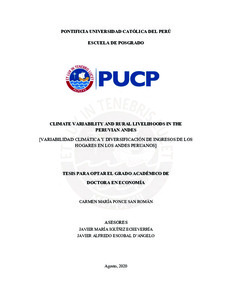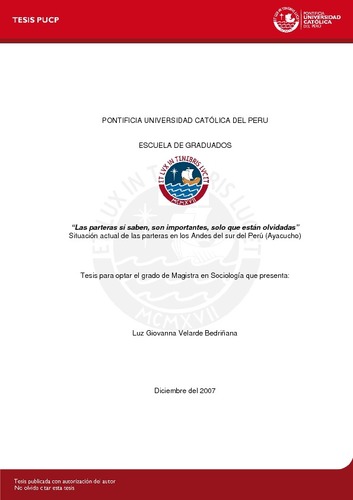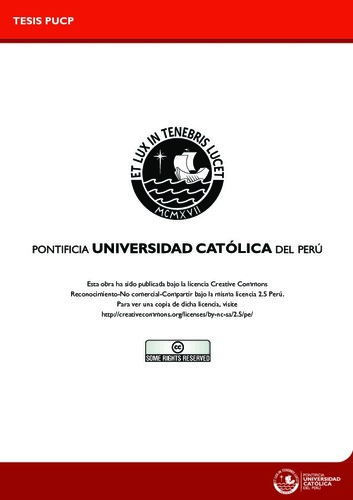Climate variability and rural livelihoods in the peruvian Andes : Variabilidad climática y diversificación de ingresos de los hogares en los Andes peruanos
Abstract
This thesis aims to understand some of the effects of changes in intra-seasonal climate variability
on household livelihoods in the Peruvian Andes. Concerns about the effects of climate change on
the sustainability of Andean agricultural systems and, in general, concerns about the ability of rural
households to adapt to increasing climate uncertainty motivate this thesis. The first study focuses
on household decisions over crop portfolio diversification as a response to increasing climate
variability. The study investigates whether Andean farmers respond by increasing crop diversity
(measured by intercropping and crop diversification indices) or by switching to crops that better
tolerate diverse environmental conditions. Based on fixed effects models that use a district panel
of 1994 and 2012 agrarian censuses, the study finds that households in colder areas (<11˚C during
the crop growing season) adapt to increases in climate variability by concentrating their portfolio
into more tolerant crops and reducing intercropping (a practice potentially efficient at controlling
pest and disease). This effect is especially strong in the Southern region (more indigenous, less
integrated to markets). Taking a broader approach, the second study focuses on Andean rural
households in general, investigating whether households adapt to increasing climate variability by
concentrating more into non-farm income generating activities (relative to farm activities), and
whether spatially distant family networks facilitate this adaptive strategy. Six economic outcomes
are modeled in this study: non-farm income shares, non-farm working hours share, farm and nonfarm
income levels, and farm and non-farm working hours. Based on generalized linear models
that use household information representative of rural provinces of the Andean region, the study
finds that households adapt differently across the region. While households in the colder areas of
the Central and Northern Andes (below 13˚C during the crop growing season) tend to increase
non-farm income as climate variability increases, households in the South show no discernible
response. The study results suggest that spatially distant family networks facilitate non-farm
opportunities to households facing increasing temperature variability in the Central and Southern
Andes. This thesis complements previous studies by providing robust and regionally representative
evidence on households’ nonlinear response to climate variability. Furthermore, given that Andean
households received little-to-no help to adapt to climate change during the period under analysis,
this study informs about household autonomous adaptation to climate change and raises concerns
on current adaptation responses that may hamper the sustainability of Andean household
livelihoods in the face of climate change.
Temas
Familias rurales--Andes, Región (Perú)
Sistemas agrícolas--Andes, Región (Perú)
Cambios climáticos--Andes, Región (Perú)
Sistemas agrícolas--Andes, Región (Perú)
Cambios climáticos--Andes, Región (Perú)
Para optar el título de
Doctor en Economía
Collections
The following license files are associated with this item:
Related items
Showing items related by title, author, creator and subject.
-
Las parteras sí saben, son importantes, solo que están olvidadas". Situación actual de las parteras en los Andes del sur del Perú (Ayacucho)
Velarde Bedriñana, Luz Giovanna (Pontificia Universidad Católica del PerúPE, 2012-01-23)El interés por la presente investigación nace de mi experiencia y formación como obstetriz en el departamento de Ayacucho. La formación universitaria poco o nada incorpora tampoco hace alusión a la existencia de otros ... -
El modelo económico de Murra sobre los Andes prehispánicos : alcances y limitaciones
Garaycochea Mejia, Carlos Federico (Pontificia Universidad Católica del PerúPE, 2011-06-27)La tesis tiene como objetivo demostrar, desde las perspectivas de la historia y la teoría económica, que la propuesta de explicación de la organización económica de las sociedades andinas prehispánicas desarrollada por ... -
Plan estratégico de la Caja Rural de Ahorro y Crédito Los Andes S.A.
Eyzaguirre Capurro, Carlos Francisco; Mita Barrionuevo, Daniel; Rivera Carpio, Enrique Martín; Valenzuela Martinez, Carlos Francisco (Pontificia Universidad Católica del PerúPE, 2017-06-15)El presente trabajo desarrolla el plan estratégico de la Caja Rural de Ahorro y Crédito Los Andes dentro de un horizonte de 10 años. Para su elaboración se ha usado el modelo propuesto por el doctor Fernando D’Alessio, ...









